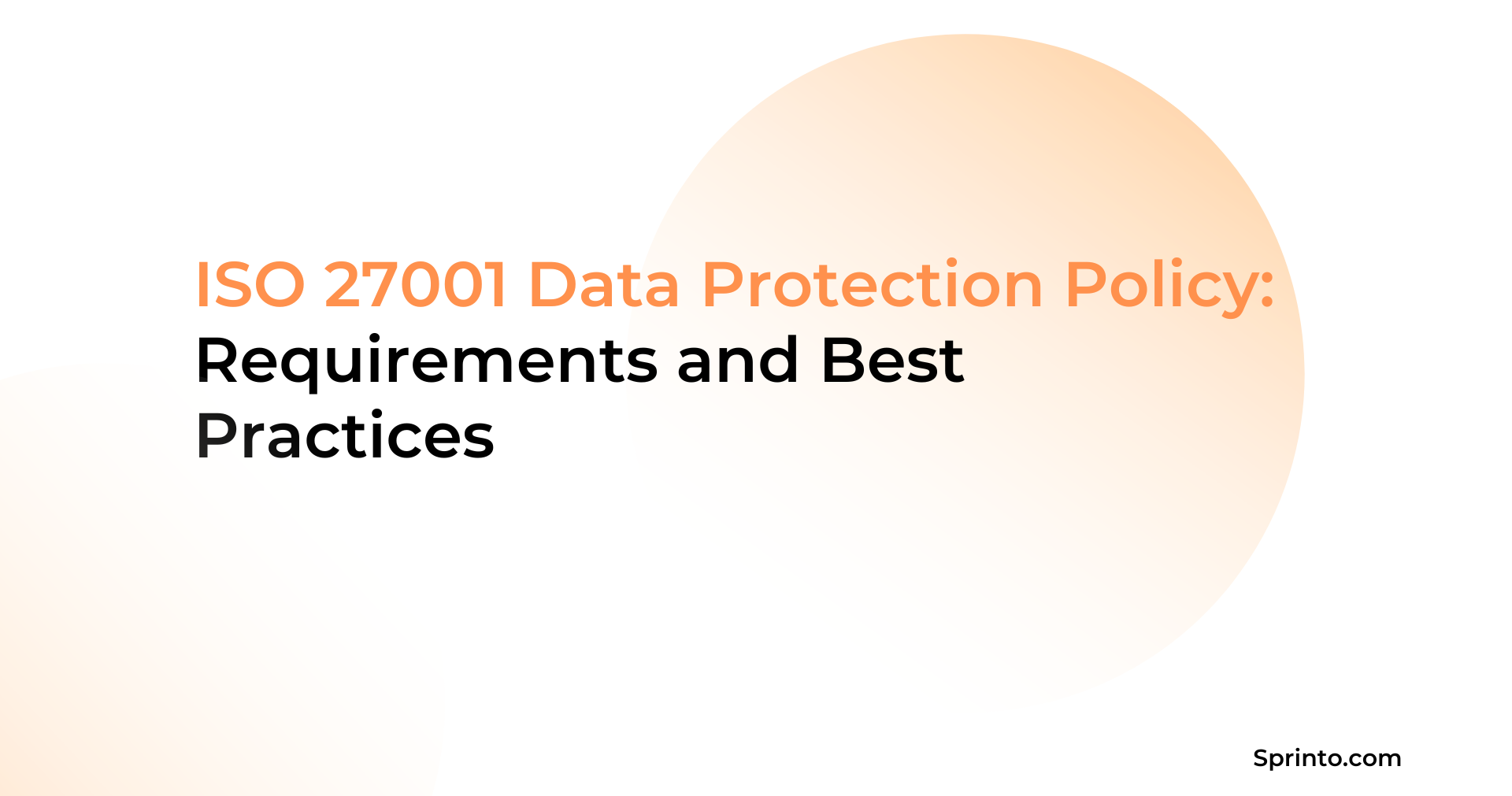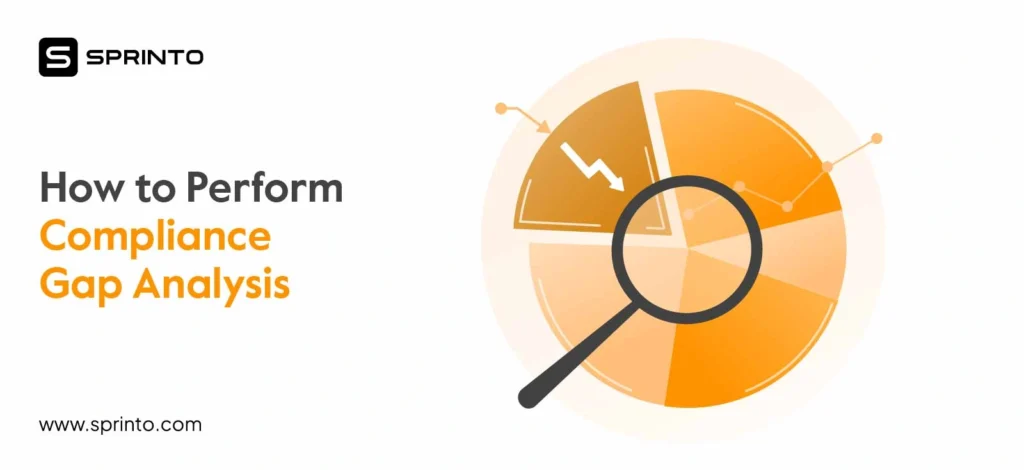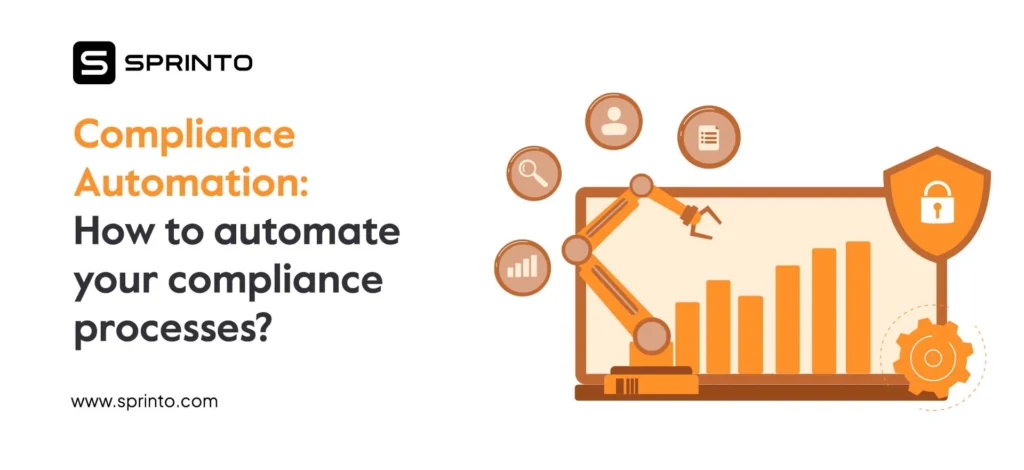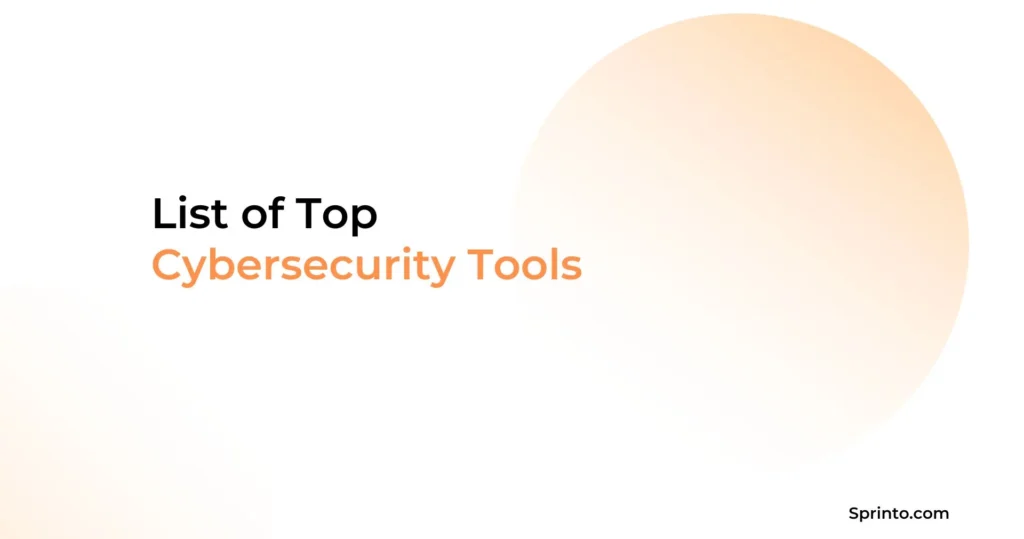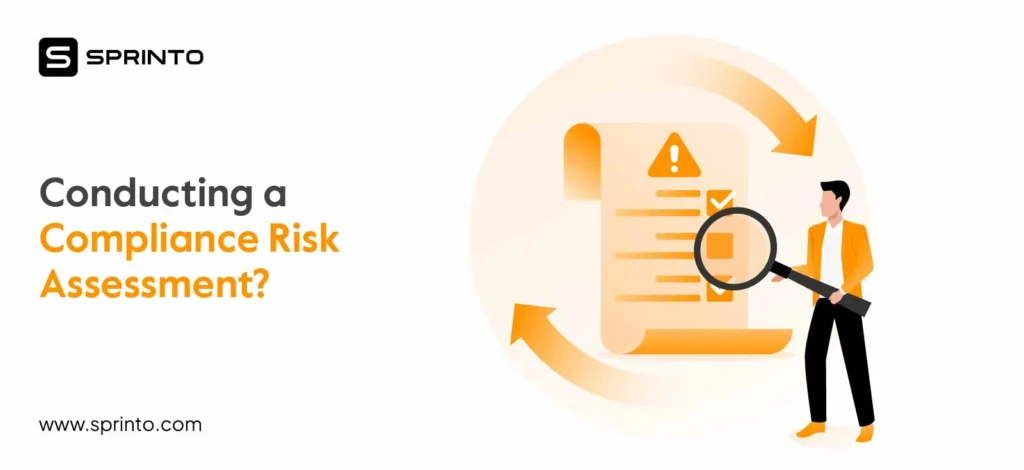Somewhere, in a dusty corner of your office, lies a document titled ‘Data Protection Policy.’ It’s a well-intentioned file, full of dense paragraphs and legal jargon. As you expect, most employees have never read it, and those who have probably forgotten what it said moments later.
This situation is too common, while it shouldn’t be.
The truth is, a data protection policy should be a clear and practical guide that helps everyone in your company make smart decisions about data.
Why? Because in times when information is currency, knowing how to protect it is your trump card. And when it comes to doing it right, the international gold standard is ISO 27001.
Don’t let the name intimidate you. In this article, we’re going to break down the ISO 27001 data protection policy into simple pieces. We’ll show you why it matters, what goes into it, and how to create one that people will use.
Let’s get started.
TL: DR
- Data is money. Protecting data is the obvious step for avoiding hefty fines (the average data breach costs millions) and, more importantly, keeping your customers’ trust.
- ISO 27001 is a flexible framework that helps you systematically identify and manage your specific information security risks.
- A strong data protection policy defines the rules for handling data, assigns responsibilities, and outlines what to do when things go wrong.
- To bring your policy to life, you have to get leadership support, train your team, and make security a part of your company culture.
Why Does Data Protection Matter?
We create and share unimaginably vast amounts of information every day. For businesses, this information — from customer details to internal financial records — is an extremely valuable asset.
Data protection is the process of protecting this important information from loss, theft, or misuse. It’s how you ensure that sensitive data is handled correctly and kept secure from those who shouldn’t have access to it, and standards like ISO 27001 make that possible.
The need for strong data protection is a business requirement for several reasons.
- First, there are legal and regulatory obligations. Governments around the world have established laws that dictate how organizations must handle personal information. Failing to comply can result in significant fines and legal consequences.
- Beyond legal duties, the financial consequences of a data breach can be severe. The global average cost of a data breach reached $4.4 million in 2025. This figure includes expenses like investigating the incident, notifying affected customers, and fixing security vulnerabilities.
- When customers trust a business with their personal information, they expect it to be kept safe. A breach often shatters that trust and, as a result, customers take their business elsewhere. In fact, studies have shown that 71% of consumers would likely stop doing business with a company if it mishandled their sensitive data.
Ultimately, you have to practice good data protection to maintain customer confidence and the long-term health of your business.
What is ISO 27001?
ISO 27001 is the leading international standard for information security. It doesn’t focus on specific technologies, but rather on an all-encompassing approach to keep information assets secure. It is a framework that helps your organization establish, implement, maintain, and continually improve an Information Security Management System (ISMS).
ISO 27001 Requirements
ISO 27001 requires you to identify potential threats to its information, assess how likely those threats are, and understand the potential impact if something goes wrong. Based on this assessment, you can then implement appropriate security controls to manage those risks effectively.
Annex A has a list of 93 potential security controls that you will choose from. These controls are grouped into four categories, as we discussed above. For data protection, many of these controls are directly relevant. For instance, there are controls related to:
- Access control: Ensuring that employees can only access the information necessary for their jobs
- Encryption: Using technology to make data unreadable to unauthorized individuals.
- Information deletion: Securely disposing of data when it is no longer needed to prevent it from falling into the wrong hands
Accelerate ISO 27001 readiness—Book a demo to automate risk assessments and implement data protection controls effortlessly.
Key Components of the ISO 27001 Data Protection policy
A data protection policy outlines your commitment to protecting information. It serves as an internal guide for your employees and details their responsibilities and the procedures they must follow when handling data.
Here are the key components that should be included in a data protection policy:
1. Scope and Objectives
This section defines who and what the policy applies to. It should cover all employees, contractors, and any third parties that handle your data. It also outlines the goals of the policy, such as complying with legal requirements, protecting customer privacy, and keeping the company’s reputation safe.
2. Data Protection Principles
A good policy will be guided by the basic elements of data protection principles. These often include
- Data minimization: Collecting only the data that is absolutely necessary for a specific purpose
- Purpose limitation: Using data only for the specific reasons it was collected for
- Transparency: Being open and transparent with people about how their data is being used
3. Roles and Responsibilities
This part assigns responsibility for data protection. While everyone in the company has a role to play, this section will define specific duties for certain positions, such as a Data Protection Officer, IT staff, and department managers. It ensures clear ownership and accountability.
4. Data Classification
Not all data is equally sensitive. This component proposes a system for categorizing data based on its level of confidentiality. This classification helps determine the appropriate security measures needed for different types of information.
5. Data Handling Procedures
This is the policy’s practical part. It sets the rules for how data should be handled throughout its lifecycle, from creation to disposal. This includes guidelines on secure storage, safe data transfer methods (like encryption), and proper techniques for destroying data when it’s no longer needed.
6. Data Breach Response Plan
The policy should briefly describe the steps to be taken in the event of a data breach. This includes how to identify a breach, who needs to be notified, and the process for containing the damage and preventing it from happening again.
7. Training and Awareness
A policy is only effective if people know about it and understand it. This section states your commitment to providing regular data protection training for all employees so that they know their responsibilities.
Accelerate ISO 27001 certification—Schedule a demo and automate evidence collection and policy management.
ISO 27001 Data Protection Policy Template
Knowing about the policy is good, but learning from one is even better.
Here’s a template you can learn from and use as a starting point for your organization. This template is designed to be comprehensive, but you must adapt it to fit the needs, context, and legal requirements of your business.
Download the Data Protection Policy for Free!
Steps to Implement a Data Protection Policy
Creating a data protection policy is a considerable achievement, but the real work begins with its implementation. A policy document on a shelf is ineffective; it must be actively integrated into your organization’s daily operations.
Here is a clear path you can follow to bring your data protection policy to life:
Step 1: Secure Leadership Buy-in and Form a Team
Before anything else, you need the full support of your company’s leadership. Present the policy to them and explain its importance not just for compliance but as a business function that protects the organization from financial loss and reputational damage. Leadership buy-in gives you the authority and resources needed for implementation.
Once you have their support, form a small, cross-functional team to champion the process. This team would include representatives from IT, HR, legal, and key business departments, as they can provide insights into how data is used across the company.
Step 2: Conduct a Comprehensive Risk Assessment and Data Mapping
You cannot protect what you do not understand. You must identify where your sensitive data resides and what threats it faces. This involves two key activities
- Data mapping: Create an inventory of the data your organization collects, processes, and stores. For each type of data, document where it comes from, where it is kept, who has access to it, and how long you keep it.
- Risk assessment: With your data map in hand, identify potential threats and vulnerabilities. What could go wrong? This might include threats like cyberattacks, employee error, or physical theft. For each risk, evaluate its likelihood and potential impact.
Step 3: Customize and Finalize Your Data Protection Policy
Using the information you got from your risk assessment and data mapping, you can now customize the policy to your organization’s specific circumstances.
For example, your data handling procedures should address the specific types of data you work with and the risks you’ve identified.
If your employees regularly handle sensitive customer financial data, your policy should include precise rules about how that data is stored and transferred. Involve your implementation team in this process to ensure the policy is practical and relevant for different departments.
Once done, have the policy formally approved by senior management.
Step 4: Develop Supporting Procedures and Classify Data
Your high-level policy needs to be supported by more detailed, practical procedures. For example, if your policy states that data must be securely disposed of, you need a separate procedure document that details exactly how to do that for different types of media, like shredding physical documents or using specific software to wipe hard drives.
A data classification scheme is another important part. This involves categorizing your data (public, internal, confidential, restricted) based on its sensitivity.
This classification will then dictate the level of security required. For instance, ‘restricted’ data needs encryption at all times, while ‘Public’ data would not.
Step 5: Communicate the Policy and Train Your Employees
The single most important factor in the success of your policy is your people. A policy is only effective if employees are aware of it, understand it, and know how to follow it. Launch a company-wide communication campaign to introduce the new policy. Explain why it is important and how it will affect day-to-day work.
Follow this up with mandatory training for all employees. This training should be practical and role-based. For instance, your sales team needs to understand the rules for handling customer data, while your IT staff needs in-depth training on the technical security controls.
Plan for regular refresher courses and continuous awareness initiatives to keep data protection a priority.
Step 6: Integrate the Policy Into Business-as-usual
For the policy to stick, it must become part of the normal way of doing business. Incorporate data protection responsibilities into job descriptions and performance reviews. Build security checks into your processes for developing new products or services.
Like before launching a new application, conduct a privacy impact assessment to ensure it complies with your policy from the outset.
Step 7: Monitor, Review, and Improve
Since the threat landscape is constantly changing and your business also keeps evolving, you cannot afford to leave your data protection policy untouched.
Schedule regular audits and reviews of your data protection practices to ensure they are working as intended and that the policy is being followed. Use the findings from these reviews to make improvements.
This cycle of monitoring and improving is a core concept of ISO 27001 and is a must for maintaining a strong and resilient data protection posture over the long term.
Best Practices for ISO 27001 Data Privacy Policy Implementation
Implementing an ISO 27001 privacy policy in your organization is a big deal, and it will hardly go right on the first try. However, with a few best practices, you can guarantee that your efforts lead to a lasting and effective security culture.
Lead From the Top and Cultivate a Security-first Culture
The most effective data protection programs have strong, visible support from senior leadership. When leaders consistently talk about the importance of security and model secure behaviors, it sends a powerful message to the entire organization.
This shifts the mindset from viewing security as just an IT problem to seeing it as a shared responsibility. The goal is to build a culture where every employee instinctively considers the security implications of their actions, whether they are sending an email or developing a new piece of software.
Embrace Privacy by Design
Instead of adding security measures to a project or system after it has already been built, add data protection considerations from the beginning. This concept, often called privacy by design, is more efficient and effective.
When starting any new project involving personal data, ask these questions: What data do we need? How can we best protect it? How will we securely delete it when it’s no longer needed?
Building privacy in from the start reduces risk and avoids costs later on.
Keep It Simple and Accessible
While your formal policy document needs to be comprehensive, make sure you also create user-friendly summaries and guides for employees.
Avoid overly technical jargon. Use checklists, short videos, and FAQs to make the core principles easy to understand and remember.
The policy itself should be stored in a location that is easy for everyone to find, such as the company intranet.
Manage Your Vendor Risk From the Start
Your data protection shouldn’t stop at your own organization’s doors. If you share data with third-party vendors or service providers, their security weaknesses can become your liability. Before engaging any new vendor, conduct due diligence on their security practices.
Ensure that your contracts include clear data protection clauses that legally obligate them to protect your data to the same standard that you do.
Get your ISO 27001 Data Privacy Certification with Sprinto
Doesn’t getting ready for an ISO 27001 audit mean a mountain of work? Yes, there are risks to assess, controls to implement, evidence to collect, and endless documents to manage.
However, there’s a better way. A compliance automation platform like Sprinto makes the entire process smoother and much less manual.
Here’s how Sprinto simplifies your ISO 27001 certification:
- Automated evidence collection: Sprinto continuously collects evidence directly from your systems. For instance, it can automatically check if your cloud storage is encrypted or if new employees have completed their security training, saving you hundreds of hours.
- Guided risk assessment: Sprinto guides you through a structured risk assessment process and helps you identify threats and vulnerabilities relevant to your business. The platform then suggests the appropriate security controls to address those risks.
- Ready-to-use policy templates: You don’t have to start from scratch when writing your policies. Sprinto offers a library of auditor-approved policy templates that are mapped to ISO 27001 requirements. You can easily customize these to fit your organization and then use the platform to track employee acknowledgments.
- Continuous monitoring and alerts: Sprinto monitors your environment around the clock. The platform alerts you in real-time if a setting change or an added resource does not meet your security rules.
- Organized audits: When it’s time for your audit, Sprinto presents gathered evidence on an accessible auditor-grade dashboard, drastically reducing the back-and-forth and making the entire audit process more efficient.
Sprinto takes the repetitive, manual, and error-prone tasks out of ISO 27001 compliance. It turns the messy certification process into a more manageable, automated workflow. You get certified faster and also build a stronger, more sustainable security program.
Talk to our compliance experts today.
FAQs
While both are respected security standards, they have different purposes.
ISO 27001 focuses on providing a framework for you to build and manage your own ISMS. The certification proves that you have a comprehensive and risk-based security program in place.
SOC 2, on the other hand, is a report prepared by an independent auditor that attests to how well your company’s controls protect customer data. It’s focused on one or more of the five Trust Services Criteria. A SOC 2 report is often requested by customers who want detailed assurance about how you are specifically handling their data.
The timeline for ISO 27001 certification can vary quite a bit depending on a few factors, such as the size and complexity of your organization and how many security practices you already have in place. For a small to medium-sized business starting from scratch, the process typically takes anywhere from 6 to 12 months.
This timeframe includes the initial steps of conducting a risk assessment and writing policies, the core implementation phase where you roll out new controls and procedures, and finally, the two-stage formal audit process with a certification body.
While Sprinto is an excellent tool for ISO 27001, it is designed to meet all your compliance needs. This means you can use it to also get ready for audits like SOC 2, GDPR, CCPA, and HIPAA, among others.
The great thing about this is the efficiency it brings. Many security controls overlap between different frameworks. Sprinto helps you map these overlapping controls, so you don’t have to duplicate your work. The evidence you collect for one standard can often be reused for another.
Pansy
Pansy is an ISC2 Certified in Cybersecurity content marketer with a background in Computer Science engineering. Lately, she has been exploring the world of marketing through the lens of GRC (Governance, risk & compliance) with Sprinto. When she’s not working, she’s either deeply engrossed in political fiction or honing her culinary skills. You may also find her sunbathing on a beach or hiking through a dense forest.
Explore more
research & insights curated to help you earn a seat at the table.



